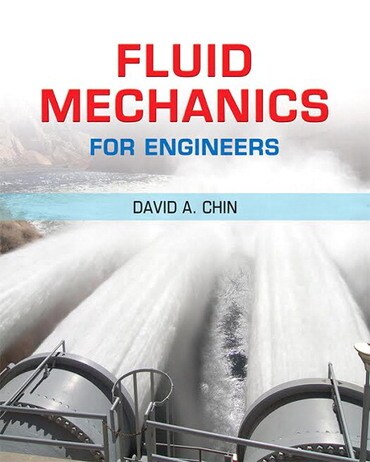
Title overview
For courses in fluid mechanics.
Introduces engineering students to the principles of fluid mechanics.
Written and conceived by an author with decades of relevant experience in the fields of fluid mechanics, engineering, and related disciplines, this First Edition of Fluid Mechanics for Engineers effectively introduces engineering students to the principles of fluid mechanics. With the understanding that fluid mechanics is a required core course for most engineering students, the author focuses first and foremost on the most essential topics of the field. Practical applications for several engineering disciplines are considered, with a special focus on civil engineering. Elective topics are also included for instructors’ consideration with regard to specific courses. Written in a stimulating style, Fluid Mechanics for Engineers fulfills the requirements of a core course while keeping students engaged.
Also available with MasteringEngineering™.
This title is also available with MasteringEngineering -- an online homework, tutorial, and assessment program designed to work with this text to engage students and improve results. Interactive, self-paced tutorials provide individualized coaching to help students stay on track. With a wide range of activities available, students can actively learn, understand, and retain even the most difficult concepts.
The text and MasteringEngineering work together to guide students through engineering concepts with a multi-step approach to problems.
Students, if interested in purchasing this title with MasteringEngineering, ask your instructor for the correct package ISBN and Course ID. Instructors, contact your Pearson representative for more information.
About the Book
- Introduces engineering students to the principles of fluid mechanics in a stimulating and practical style, with a particular focus on the principles that engineering students are most likely to apply in their subsequent undergraduate coursework.
- Material is presented in a thorough and rigorous fashion, featuring practical examples that apply to several engineering disciplines; civil engineering applications are particularly prevalent.
- Quantitative examples and illustrations related to the topics of fluid mechanics are provided throughout.
- Emphasizes the fundamentals of fluid mechanics, including fluid properties, fluid statics, basic concepts of fluid flow, and the forms of the governing equations that are useful in solving practical problems.
- The most useful relationships are highlighted to assist in solving practical problems.
- Key equations are listed at the end of each chapter.
- Sequenced with all topics considered essential to core engineering courses in fluid mechanics presented first:
- Properties of fluids (Chapter 1)
- Fluid statics (Chapter 2)
- Kinematics and streamline dynamics (Chapter 3)
- Finite-control-volume analysis (Chapter 4)
- Dimensional analysis and similitude (Chapter 6)
- Flow in closed conduits (Chapter 7)
- Several elective topics also included which may be studied in relevant courses and disciplines:
- Differential analysis (Chapter 5)
- Turbomachines, coverage of which is sometimes considered a mandatory component of a first course in fluid mechanics in civil, environmental, and mechanical engineering curricula (Chapter 8)
- Flow in open channels, an essential coverage area for civil and environmental engineering which may not always be covered in a first course in fluid mechanics (Chapter 9)
- Drag and lift (Chapter 10)
- Boundary layer flow (Chapter 11)
- Compressible flow (Chapter 12)
Also available with MasteringEngineering™.
MasteringEngineering is an online homework, tutorial, and assessment program designed to work with this text to engage students and improve results. Interactive, self-paced tutorials provide individualized coaching to help students stay on track. With a wide range of activities available, students can actively learn, understand, and retain even the most difficult concepts.
The text and MasteringEngineering work together to guide students through engineering concepts with a multi-step approach to problems.
- Learning Catalytics™ generates class discussion, guides your lecture, and promotes peer-to-peer learning with real-time analytics. MyLab & Mastering with eText now provides Learning Catalytics–an interactive student response tool that uses students’ smartphones, tablets, or laptops to engage them in more sophisticated tasks and thinking.
Instructors, you can:
- Pose a variety of open-ended questions that help your students develop critical thinking skills
- Monitor responses to find out where students are struggling
- Use real-time data to adjust your instructional strategy and try other ways of engaging your students during class
- Manage student interactions by automatically grouping students for discussion, teamwork, and peer-to-peer learning
- Learning Outcomes are included with all assignable MasteringEngineering content and tagged to ABET Learning Outcomes A, E, & K. Mastering enables you to add your own learning outcomes and associate those with the Mastering content. Learning Outcomes Summaries will allow you to track student or class level performance for both publisher-provided learning outcomes and your own custom learning outcomes.
- Coaching Activities are assignable items in the MasteringEngineering content library, combining the popular Video Solutions resource with a corresponding assessment questions.
Table of contents
- Properties of Fluids
- Fluid Statics
- Kinematics and Streamline Dynamics
- Finite Control Volume Analysis
- Differential Analysis
- Dimensional Analysis and Similitude
- Flow in Closed Conduits
- Turbomachines
- Flow in Open Channels
- Drag and Lift
- Boundary-Layer Flow
- Compressible Flow